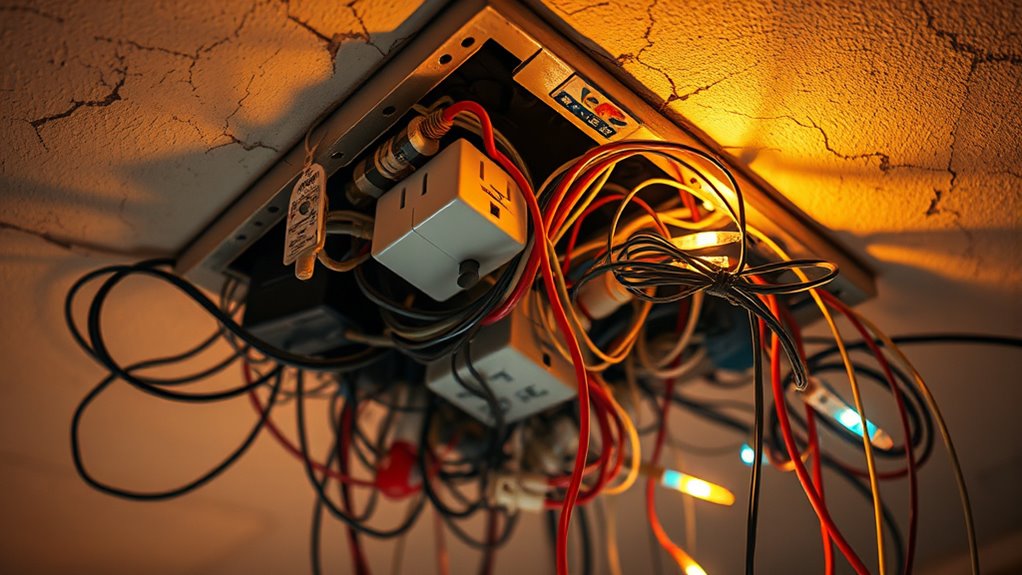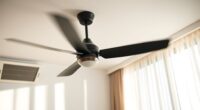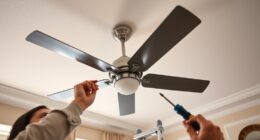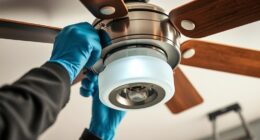To guarantee ceiling box safety during seasonal changes, regularly inspect your fixtures for loose wires, corrosion, or unstable mounts. Reinforce support for heavy decorations by using brackets attached to ceiling joists, and upgrade to code-compliant boxes if needed. Be mindful of electrical load by distributing lighting across circuits and turning off unused fixtures. Staying proactive with maintenance and safety checks can prevent hazards; exploring more details helps keep your home secure year-round.
Key Takeaways
- Regularly inspect ceiling boxes for secure mounting, corrosion, and wiring integrity before seasonal decorating.
- Ensure fixtures are properly supported with brackets and anchored to prevent accidents during heavy holiday displays.
- Check circuit capacity and avoid overloading outlets to prevent tripped breakers and electrical hazards.
- Replace outdated or damaged ceiling boxes to meet safety standards and support modern lighting or controls.
- Turn off power and verify wiring connections are tight and insulated when installing or maintaining fixtures.
Inspecting Ceiling Boxes Before Seasonal Changes

As seasons change, it’s important to inspect your ceiling boxes to guarantee they remain safe and secure. Check that decorative lighting fixtures are firmly attached and wires are in good condition to prevent any electrical issues. If you’re planning a ceiling fan installation or updating existing fixtures, ensure the box is rated for the weight and type of fixture you choose. Loose or damaged boxes can cause safety hazards or damage to your decor. Look for signs of wear, corrosion, or unstable mounting. Tighten any loose screws and replace damaged components before installing new lighting or fans. Performing a safety check of your ceiling boxes regularly can prevent accidents and ensure your fixtures are properly supported. Doing this seasonal inspection helps avoid accidents and ensures your ceiling boxes support your decorative lighting and ceiling fan installation safely and effectively.
Ensuring Proper Support for Heavy Decorations

To safely hang heavy decorations from your ceiling, you need to guarantee the ceiling box can support the weight. First, assess the decorative weight you plan to hang. Standard ceiling boxes often aren’t designed for substantial loads, so you may need to reinforce them. Support brackets are essential tools for this purpose; they help distribute the weight evenly across the ceiling joists. Secure the support brackets tightly to the ceiling joists, then attach the ceiling box firmly to these brackets. This setup ensures your decorations won’t cause the box to pull free or damage your ceiling. Always verify the maximum weight capacity of your ceiling box, and upgrade to a more robust box if necessary. Proper support prevents accidents and keeps your decorations safely in place. Additionally, choosing Kia Tuning options like upgraded suspension or load-bearing brackets can improve the overall safety of hanging heavy items.
Upgrading to Code-Compliant Ceiling Boxes

Upgrading to a code-compliant ceiling box is vital for guaranteeing safety and meeting electrical standards. When you replace outdated or non-compliant boxes, you reduce the risk of electrical hazards and ensure your fixtures are secure. Modern boxes often support wireless controls, making it easier to manage lighting remotely and safely during seasonal decorations. Additionally, upgrading allows you to install decorative covers that hide wiring and enhance aesthetics, especially with holiday lighting. A compliant ceiling box provides proper support and grounding, preventing accidents or damage. It also ensures proper paint sprayer compatibility, making future upgrades or repairs more straightforward. It’s an imperative step to prepare your home for safe seasonal decorating while maintaining a clean, professional look. By prioritizing code compliance, you guarantee both safety and functionality during every season.
Securing Electrical Fixtures for Holiday Lighting

When securing holiday lighting fixtures, make sure they are properly anchored to prevent accidents. Check that all electrical connections are tight and safe to guarantee shorts or fires. Taking these steps ensures your decorations stay secure and your home remains safe. Additionally, utilizing smart technology can help monitor and control your lighting setup for enhanced safety and convenience.
Proper Fixture Anchoring
Securing electrical fixtures properly is essential to guarantee safety during holiday lighting installation. You need to ensure fixture stability by firmly anchoring the fixture to the ceiling box. Use the correct mounting hardware designed for the weight and type of your fixture. Check that the mounting bracket is securely attached to the ceiling box, and reinforce the anchor if necessary, especially for heavier lights. Proper anchor reinforcement prevents the fixture from loosening or falling, which can cause injury or damage. Avoid over-tightening screws, as this can weaken the fixture or the box. Regularly inspect the anchoring points once installed, especially during the holiday season when fixtures are often handled or adjusted. Proper fixture anchoring is the key to a safe, secure holiday lighting display and contributes to personal safety.
Electrical Connection Safety
Ensuring electrical connections are secure is essential for safe holiday lighting. Loose or poorly made wire connections can lead to sparks, shorts, or even fires. Before hanging your lights, double-check all wire connections, making sure they’re tight and properly insulated. Pay special attention to grounding issues, as improper grounding can cause electrical shocks or damage to fixtures. Use wire connectors designed for outdoor use if your lights are outside, and avoid exposed or frayed wiring. Always turn off power before working on connections to prevent accidents. Proper grounding and secure wire connections help prevent electrical faults that could ruin your holiday decor or create safety hazards. Additionally, understanding electrical connection safety can help you identify potential risks and prevent hazards during setup. Taking these precautions ensures your festive display remains safe and enjoyable throughout the season.
Using Appropriate Ladder Safety Practices

To work safely on a ladder while installing or maintaining ceiling boxes, you need to follow proper ladder safety practices. Always inspect your ladder first—check for loose rungs, stability, and any damage. Use safety harnesses when working at heights to prevent falls, especially if the ladder feels unstable. Maintain three points of contact—both feet and one hand or two hands and one foot—at all times. Position the ladder on a flat surface and avoid overreaching. Being aware of input lag and how it affects your safety equipment can further reduce risks during maintenance. Proper ladder placement and avoiding overreach also help maintain stability and safety.
Preventing Overloading Circuits During Peak Seasons

During peak seasons, overloading circuits can cause safety hazards. You should monitor your circuit capacity, limit the use of high-power devices, and plan seasonal usage to prevent overloads. Taking these steps guarantees your ceiling box and wiring stay safe and reliable. Additionally, practicing space organization can help you better manage electrical loads and reduce clutter that may contribute to overload risks.
Monitor Circuit Capacity
Monitoring circuit capacity is essential to prevent overloading, especially during peak seasons when electrical demand surges. You need to verify your circuit breaker coordination is up to date, so breakers trip safely before wiring capacity limits are exceeded. Regularly check the total load on each circuit, including ceiling boxes and connected devices, to avoid surpassing safe limits. Overloading can cause overheating and potential fire hazards, so staying within recommended wiring capacity limits is vital. Use a clamp meter or a load tester to measure current flow during busy periods. If you notice any signs of strain, such as flickering lights or tripped breakers, reduce the load immediately. Vigilant monitoring helps protect your home, guaranteeing safety and preventing costly electrical issues during high-demand seasons. Additionally, understanding the importance of proper air quality can help maintain a safe environment, especially when electrical systems are under stress.
Limit High-Power Devices
Are high-power devices pushing your circuit capacity to the limit? During peak seasons, avoid overloading circuits by limiting the use of high-power devices like large decorative fixtures and appliances. Overloading can trip breakers or cause wiring hazards. To manage this, distribute devices across different circuits when possible, and use wireless controls to turn off unused fixtures remotely. Keep in mind that some decorative fixtures draw significant power, especially if connected with multiple bulbs. Additionally, consider the electrical system’s capacity to ensure safe operation during busy seasons.
Schedule Seasonal Usage
To prevent overloading circuits during peak seasons, it’s essential to plan and schedule the use of high-power devices carefully. If you’re using decorative lighting or seasonal decorations, spread out their installation and operation across different circuits or times. Avoid plugging all decorative lighting into a single outlet or circuit, especially during holidays when multiple devices run simultaneously. Consider turning on seasonal decorations in stages rather than all at once to reduce the load. This approach helps prevent tripped breakers and potential electrical hazards. Regularly check your circuit capacity and avoid exceeding it. Proper scheduling ensures your festive displays remain safe and functional without risking overloads or damaging your ceiling box wiring. Additionally, being aware of potential electrical hazards can help you take proactive steps to safeguard your home during busy holiday seasons.
Regular Maintenance and Safety Checks Throughout the Year

Regular maintenance and safety checks are essential to guarantee your ceiling box remains secure and functioning properly throughout the year. You should routinely inspect your decorative lighting fixtures to ensure they’re firmly attached and wires are in good condition. Pay attention to any signs of wear or fraying, and replace damaged components promptly. Ceiling fan maintenance is equally important; make sure the fan is securely mounted, blades are balanced, and electrical connections are tight. Regularly check for loose screws or connections in your ceiling box, and tighten them as needed. Keeping up with these safety checks prevents potential electrical hazards and prolongs the lifespan of your fixtures. Additionally, monitoring the condition of electrical components and following proper maintenance protocols can help prevent issues similar to those identified in aerospace safety practices. A little effort now saves you from costly repairs or accidents later.
Frequently Asked Questions
How Often Should Ceiling Boxes Be Inspected for Safety?
You should inspect ceiling boxes for safety at least once a year, aligning with recommended safety check intervals. Regular inspection helps identify loose connections, damaged wiring, or signs of wear that could pose hazards. If you notice any issues or if your home has experienced events like storms or renovations, perform inspections more frequently. Staying proactive guarantees your ceiling boxes remain secure and safe, preventing potential electrical problems or accidents.
What Are the Signs of a Ceiling Box Needing Replacement?
Did you know that over 60% of electrical fires start due to ceiling box deterioration? You should replace your ceiling box if you notice loose fittings, burn marks, or frayed wiring, as these signs indicate electrical wear. Cracks, corrosion, or sagging also signal it’s time for a replacement. Addressing these issues promptly helps prevent hazards and keeps your home safe. Always consult a professional if you’re unsure.
Can DIY Upgrades Meet Current Electrical Codes?
Yes, DIY upgrades can meet current electrical codes if you follow proper safety procedures and local regulations. You need to understand electrical compliance requirements and make certain all work is up to code. Always turn off power before starting, use the correct tools, and double-check connections. If you’re unsure, consult a professional to guarantee safety and compliance, avoiding potential hazards and ensuring your project passes inspections.
What Types of Decorations Require Additional Ceiling Box Support?
Oh, the thrill of hanging decorative lighting or heavy fixtures—who wouldn’t want their ceiling to turn into a gravity-defying spectacle? You need additional ceiling box support for these beauties, especially if they’re bulky or heavy. Standard boxes won’t cut it; opt for reinforced or supplemental support to prevent a dramatic crash. Remember, your ceiling isn’t a stage for DIY stunts—support it properly to keep everything safely overhead.
Are There Specific Safety Precautions for Outdoor Ceiling Boxes?
Yes, outdoor ceiling boxes require extra safety precautions. You should weatherproof the box with appropriate covers to prevent moisture damage and follow electrical grounding requirements to guarantee safety. Always check that the box is rated for outdoor use and securely sealed against weather elements. Proper wiring and grounding help prevent electrical hazards, especially in wet conditions. Regularly inspect outdoor boxes for damage or corrosion to maintain safe operation.
Conclusion
Think of your ceiling box safety as the steady heartbeat of your home’s festive spirit. When you stay vigilant—inspecting, supporting, and securing—you keep the rhythm smooth and strong. Regular maintenance acts as your home’s pulse, preventing surprises during the busiest seasons. By following these safety steps, you ensure your holiday cheer flows seamlessly, like a well-orchestrated symphony. Keep safety in sync, and your celebrations will shine brightly without a hitch.






